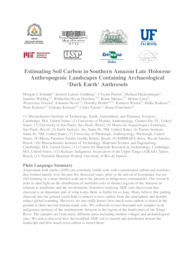Estimating soil carbon in Southern Amazon late holocene anthropogenic landscapes containing archaeological 'Dark Earth' Anthrosols.
Estimating soil carbon in Southern Amazon late holocene anthropogenic landscapes containing archaeological 'Dark Earth' Anthrosols.
Resumo: Amazonian dark earths (ADE) are anthropogenic soils with concentrated carbon and nutrients that formed mainly during the latter half of the Holocene, prior to the arrival of Europeans, but are still forming on a more limited scale up to the present in indigenous communities. ADE, a result of domestic, economic, and agricultural activities in and around human settlements, are noted for their extraordinary fertility and resilience and for the significant quantities of organic carbon, much in the form of charcoal. The deepest and most extensive areas of ADE are generally located on the bluffs of major rivers adjacent to floodplains, but significant areas of ADE have also been found in floodplains and in headwater and interfluvial areas. Our research aims to shed light on the distribution of modified soils in distinct regions of the Amazon in relation to landforms and the environment. Research on ADE has led to the development of a 'biochar' industry that promotes the incorporation of charcoal into the soil for the dual purpose of improving fertility and sequestering carbon, but the potential for large-scale carbon storage in anthropogenic soils is unclear, in part because the amount of carbon already stored in ADE is unknown as there is a notable lack of research attempting to quantify the carbon over the scale of a site or region. We undertook this challenge in the Upper Xingu region of southeastern Amazonia in partnership with the local Kuikuro indigenous community who have shared their valuable traditional knowledge on the creation and management of ADE. We used data from over 3500 soil samples from diverse contexts, both ancient and modern, that we collected and analyzed over the past two decades for organic carbon and a range of other chemical and physical properties that can serve as proxies for soil modification by humans. Dark earth samples from profiles down to 1 m depth in archaeological sites ranged from 20% to 150% more OC than unmodified forest soil and dark earth profiles in current and historic villages ranged from 20-90% more organic carbon. We used the results from soil sample transects to estimate the carbon in landuse zones within and surrounding modern, historic, and ancient settlement sites. In continuing work, we are attempting to use satellite remote sensing and AI to extrapolate our results across a larger region.
Ano de publicação: 2020
Tipo de publicação: Artigo em anais e proceedings
Unidade: Embrapa Solos
Observações
1 - Por padrão são exibidas publicações dos últimos 20 anos. Para encontrar publicações mais antigas, configure o filtro ano de publicação, colocando o ano a partir do qual você deseja encontrar publicações. O filtro está na coluna da esquerda na busca acima.
2 - Para ler algumas publicações da Embrapa (apenas as que estão em formato ePub), é necessário ter, no celular ou computador, um desses softwares gratuitos. Sistemas Android: Google Play Livros; IOS: iBooks; Windows e Linux: software Calibre.
Acesse outras publicações
Acesse a Base de Dados da Pesquisa Agropecuária (BDPA) para consultar o acervo completo das bibliotecas da Embrapa.

